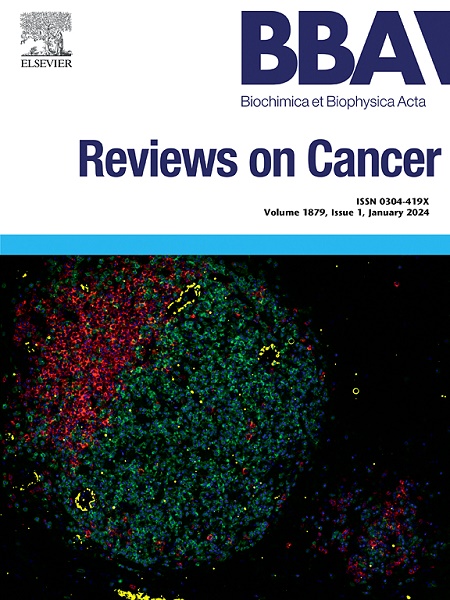非规范RNA二级结构在肿瘤中的作用和机制
IF 9.7
1区 医学
Q1 BIOCHEMISTRY & MOLECULAR BIOLOGY
Biochimica et biophysica acta. Reviews on cancer
Pub Date : 2025-05-30
DOI:10.1016/j.bbcan.2025.189363
引用次数: 0
摘要
近年来,RNA二级结构的研究取得了重大突破。典型结构,如发夹、内环和茎环,在基因表达调控、基因组稳定性和转录后控制中的作用已被广泛认识。与此同时,非规范RNA二级结构,如r -环、RNA g -四plex (rG4s)、Z-RNA、假结等因其独特的生物学功能而受到越来越多的关注,成为研究的前沿。这些结构在基因调控和肿瘤发生中的关键作用逐渐显现,凸显了它们的重要性。由RNA-DNA杂交体组成的r -环在基因组稳定性、转录调控和DNA修复中发挥核心作用;它们的异常积聚与肿瘤发生密切相关。rG4调节癌基因的翻译和稳定性,为靶向癌症治疗提供了潜在的途径。虽然Z-RNA仍处于早期研究阶段,但其在干扰素信号传导和免疫逃避中的独特作用为癌症免疫治疗开辟了新的途径。假结作为高度复杂的RNA二级结构,在调节肿瘤相关基因的翻译效率和功能稳定性方面发挥着不可或缺的作用。针对这些RNA结构的小分子药物和RNA编辑技术的最新进展显示了它们在癌症诊断和治疗中的潜在应用。本文就R-loops、rG4、Z-RNA和伪结的形成机制、作用及肿瘤相关研究进展作一综述。它深入研究了它们在癌症中的机制,概述了它们在精准医学中的潜在应用,并讨论了面临的挑战,为RNA结构领域的未来研究提供了创新的见解和方向。本文章由计算机程序翻译,如有差异,请以英文原文为准。
The roles and mechanisms of non-canonical RNA secondary structures in tumors
In recent years, significant breakthroughs have been achieved in the study of RNA secondary structures. The roles of canonical structures, such as hairpins, internal loops, and stem-loops, in gene expression regulation, genome stability, and post-transcriptional control have been widely recognized. Meanwhile, non-canonical RNA secondary structures—such as R-loops, RNA G-quadruplexes (rG4s), Z-RNA, and pseudoknots—have garnered increasing attention due to their unique biological functions, becoming a frontier in research. The critical roles of these structures in gene regulation and tumorigenesis are gradually emerging, highlighting their importance. R-loops, composed of RNA-DNA hybrids, play central roles in genome stability, transcriptional regulation, and DNA repair; their abnormal accumulation is closely associated with tumorigenesis. rG4 regulates oncogene translation and stability, providing potential pathways for targeted cancer therapy. Although Z-RNA is still in its early stages of research, its unique role in interferon signaling and immune evasion opens new avenues for cancer immunotherapy. Pseudoknots, as highly complex RNA secondary structures, are indispensable in regulating the translational efficiency and functional stability of tumor-related genes. Recent progress in small-molecule drugs and RNA editing technologies targeting these RNA structures has demonstrated their potential applications in cancer diagnosis and treatment. This review provides a comprehensive perspective of the formation mechanisms, roles, and tumor-related research advancements of R-loops, rG4, Z-RNA, and pseudoknots. It delves into their mechanisms in cancer, outlines their potential applications in precision medicine, and discusses the challenges faced, offering innovative insights and directions for future research in the RNA structure field.
求助全文
通过发布文献求助,成功后即可免费获取论文全文。
去求助
来源期刊

Biochimica et biophysica acta. Reviews on cancer
医学-生化与分子生物学
CiteScore
17.20
自引率
0.00%
发文量
138
审稿时长
33 days
期刊介绍:
Biochimica et Biophysica Acta (BBA) - Reviews on Cancer encompasses the entirety of cancer biology and biochemistry, emphasizing oncogenes and tumor suppressor genes, growth-related cell cycle control signaling, carcinogenesis mechanisms, cell transformation, immunologic control mechanisms, genetics of human (mammalian) cancer, control of cell proliferation, genetic and molecular control of organismic development, rational anti-tumor drug design. It publishes mini-reviews and full reviews.
 求助内容:
求助内容: 应助结果提醒方式:
应助结果提醒方式:


